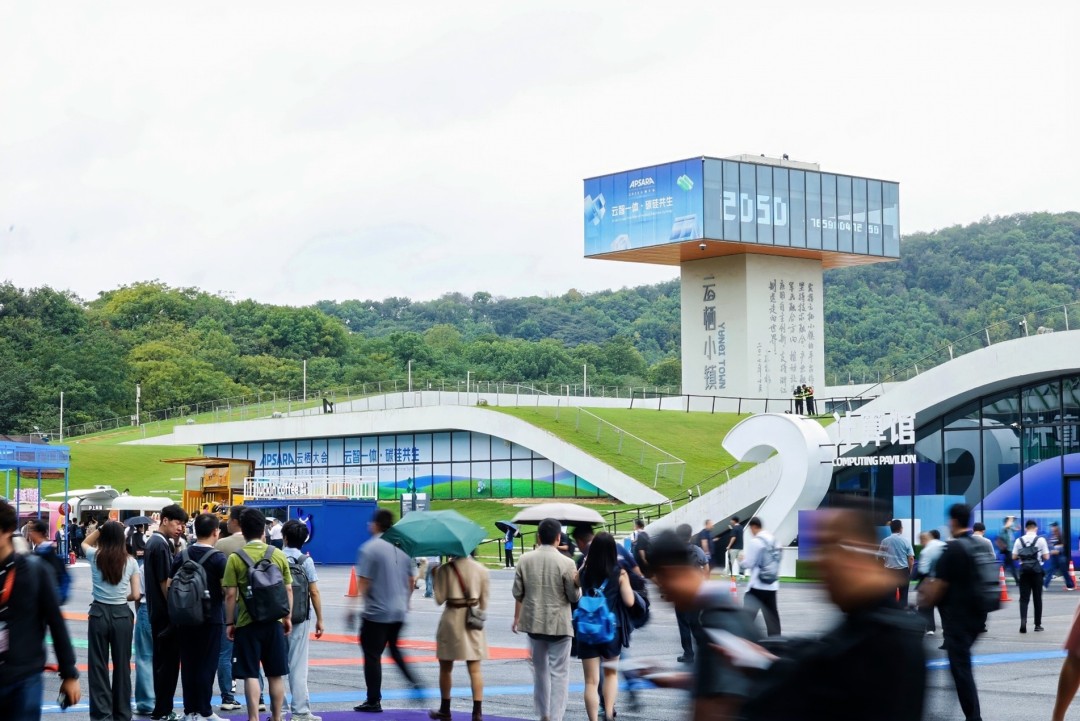On September 25, the 2025 APSARA Conference kicked off as planned under the theme “AI on Cloud: The Rise of Human-Machine Synergy,” signaling a more imaginative future —— AI is beginning to show warmth and cognitive depth, evolving into a true “digital partner.” Robots are integrating into daily life and industry as collaborative partners with seamless synergy. Meanwhile, foundation models are becoming the undercurrent that supports and elevates all applications, serving as a new cornerstone.

Tongyi’s Foundation Model Family Takes Center Stage
As a flagship highlight of the APSARA Conference, the opening day’s main forum hosted two high-level dialogues. In the morning, leading figures in the AI industry discussed AI’s future trajectory and its defining role in this era, alongside landmark annual upgrades in foundation models, intelligent agents, and AI infrastructure. In the afternoon, the focus shifted to the emerging needs of the Agentic AI era, with Alibaba Cloud announcing major breakthroughs in full-stack AI services and product innovation, and showcasing real-world applications from pioneering enterprises.
“The main forum made it clear that AI has tremendous room for growth in work, daily life, and software development — and that fills me with great expectations for the future,” Mr. Zhou said candidly. “Be it breakthroughs in foundational technologies or the real-world deployment of multimodal models across text, video, and speech, all point to the breathtaking pace at which China’s AI industry is progressing.”
As the opening pavilion of the conference, the “AI+ Pavilion” showcased the latest advances spanning foundation models, developer tools, and end-to-end agent services. The Tongyi foundation model series debuted with an open-source matrix across all scales and modalities, underscoring its broad strategy in multimodal understanding and generation. The ModelScope community highlighted the strength of its ecosystem, with more than 70,000 models and 16 million developers. Lingyang AgentOne introduced application-specific services in areas such as customer support and marketing. The AI Coding zone spotlighted shifts in developer work paradigms. Visitors could experience first-hand the development and application of intelligent agents through Alibaba Cloud’s Bailian and Wuying AgentBay, witnessing how foundation models are transforming from mere tools into trusted “digital partners.”
Tongyi Wanxiang 2.5 has received a landmark upgrade — now a single line of text is enough to instantly generate or edit images. Its image generation capabilities have been significantly upgraded, supporting Chinese and English text rendering as well as chart creation. Video generation has achieved a marked breakthrough, extending the maximum clip length from 5 to 10 seconds and supporting 24fps 1080P output, while the model’s capacity to interpret and execute complex instructions has been further refined with greater accuracy.
The much-anticipated Tongyi Foundation Model Family took the stage at the conference, introducing its flagship release Qwen3-Max, along with newly launched members Qwen3-Omni, Qwen3-VL, and Wan2.5. Notably, the lineup welcomed a significant new addition — the speech foundation model Tongyi Bailin, comprising the speech recognition model Fun-ASR and the speech synthesis model Fun-CosyVoice. Fun-ASR, trained on tens of millions of hours of authentic speech data, offers strong contextual comprehension and industry adaptability, while Fun-CosyVoice provides hundreds of ready-to-use voice profiles, widely applicable to customer service, live streaming, consumer electronics, and audio content.
From open-sourcing models and community collaboration to developer tools and computing resources, Alibaba Cloud is lowering the threshold for AI innovation by embracing openness on all fronts. ModelScope, China’s largest open-source foundation model community, now hosts over 18 million active users and more than 100,000 curated models. At this year’s conference, ModelScope rolled out its international version and unveiled the “Grand Science Plan,” aimed at cultivating a global open-source model ecosystem. It is evolving not only into a platform for model distribution, but also into an international hub for idea exchange and innovation incubation.
Meanwhile, Alibaba Cloud’s fully upgraded AI infrastructure was showcased in its entirety for the first time. It spans the entire technology stack — from underlying chips, supernode servers, high-performance networks, distributed storage, and AI computing clusters, to advanced AI platforms and model training and inference services. By unlocking this complete technology chain, AI is driving the transition from the laboratory to real-world industries, enabling every enterprise to build its competitive edge by drawing on world-class technological foundations, and helping developers worldwide advance faster toward an intelligent future through openness, collaboration, and sharing.
Unveiling the Power Behind the Model
For robots to become part of everyday life, the key lies in making their “brains” more intelligent. At the Computing Pavilion, Alibaba Cloud showcased its full-stack capabilities, spanning from in-house chips to the Wuying Cloud Desktop. The focus of computing power is shifting from CPUs to GPUs, as AI training calls for greater computing density, more efficient networks, and ever-larger clusters.
Strolling through the technology-driven pavilion, visitors could not only gain insights into Alibaba Cloud’s capabilities in large-scale clusters, distributed training, and heterogeneous resource management, but also get hands-on with the next-generation hardware built for inference and intelligent agents. The exhibition also brought together 29 software and hardware ecosystem partners — spanning chips, devices, operators, and data services — offering a clear picture of the full AI industry chain.
At the immersive showcase of Alibaba Cloud’s intelligent computing clusters, the next-generation Panjou A128 Supernode Server took center stage. Independently developed and designed by Alibaba Cloud, the server combines high density, high performance, and high availability. It flexibly supports multiple AI accelerators, with a single cabinet accommodating up to 128 AI compute chips — setting a new industry benchmark.
If technology is the “backbone” of the AI revolution, then interactive experiences are its “soul.” Inside the Computing Pavilion, cutting-edge technologies were no longer distant or abstract, but transformed into tangible, immersive, and interactive experiences.
The Wuying exhibition area drew massive crowds — a palm-sized Wuying Cube Ultra was able to seamlessly run GPU-intensive AAA games. On site, visitors could sit in a racing simulator synced with a giant screen to experience the thrill of high-speed driving, or pick up a controller to enter the world of Black Myth: Wukong and take on powerful bosses. This router-sized device, powered by Alibaba Cloud’s powerful cloud computing capacity, delivers gaming experiences that once demanded equipment worth tens of thousands of yuan — now made possible at just a few hundred.
At the Eastern Data, Western Computing pavilion, by putting on VR headsets visitors are virtually transported to data centers in Guizhou, Inner Mongolia, and Qinghai. There, they can take a close-up look at live server rooms and computing infrastructure, experiencing firsthand the progress of China’s National Computing Network.
Stepping into another VR space, visitors could stroll through a digitally rebuilt panorama of China’s majestic landscapes. Powered by Alibaba Cloud’s AIStack, this immersive journey across mountains and rivers was smooth and true-to-life, seamlessly merging the beauty of technology with that of nature.
“On the screen are several faces — can you tell which are real and which are AI-generated?” staff posed a challenge to the audience. After several attempts, many realized that the more lifelike the image, the more likely it was AI-generated. In today’s world, where synthetic images blur the line between real and fake, Alibaba Cloud is waging a security battle — using AI to fight AI.
From personalizing digital avatars, to learning coding through the playful Ice Cube Robot, to controlling real-world robots remotely — powered by robust computing capacity, AI is entering people’s lives in more diverse forms than ever before.
Notably, in the southeast corner of the Computing Pavilion sits a dedicated exhibition themed “From Mythical Flight to Technological Flight” — the “Feitian (Flight to the Sky) AI + Xihu Yunqi” showcase. More than 20 aerospace and intelligent technology companies from Xihu District are showcasing their latest technologies and services. Spanning AI foundation models, satellite applications, aerospace engines, and smart manufacturing, the zone presents a comprehensive picture of the industrial ecosystem driving the so-called “second Feitian” — a new takeoff for innovation.
The Xihu District booths attracted a large number of visitors — from government and corporate representatives to university students and fellow researchers. Many lingered to exchange ideas at the exhibits, further energizing the atmosphere on site and demonstrating Xihu District’s resolve and capabilities in advancing the “second Feitian” initiative.
Embodied AI Enters the Real World
In 2025, the Frontier Applications Pavilion, dubbed the “Frontier of Applications,” has become a true arena for robots. A “Muay Thai fighter” robot delivers fierce blows with precision, steadies its stance, and after being knocked down, springs back to its feet with human-like agility. Nearby, a robotic dog scales a platform effortlessly and, upon finishing, playfully mimics the celebratory gestures of a figure skater. In the simulated factory zone, a “worker” orchestrates dozens of robotic arms in perfect coordination, evoking the image of the Thousand-Armed Bodhisattva.
This is not a scene from a sci-fi movie, but a daily reality playing out inside Hall 3 of the 2025 APSARA Conference — a clear signal that embodied intelligence is making its way into the real world.
The Deep Robotics Product Pavilion stood out as one of the highlights of the event, showcasing robots and their ability to operate in extreme environments. On display, the “Lynx M20” quadruped robot was taking on simulated rough terrain, climbing slopes and scaling platforms with steady precision. After completing these demanding maneuvers, it even stood upright on two legs and executed a smooth backward slide.
Nearby, the DEEP Robotics X30 quadruped robot demonstrated an immersive simulation of a power inspection, accurately identifying and reading various instrument data. According to the on-site representative from DEEP Robotics, these robots have already been deployed at Ningbo Iron & Steel, replacing manual inspections in blast furnaces with temperatures reaching 50°C, and even assisting scientific expeditions in the uninhabited Hoh Xil region. “Our goal is to get robots truly working in extreme environments,” the representative noted. Embodied intelligence is now venturing deep into the so-called “three highs” — high temperature, high humidity, and high risk — taking on tasks far beyond human endurance.
Making its first appearance at the APSARA Conference, Leju Robotics set up a full simulated production line on site. Its robots demonstrated key industrial processes such as grasping and material handling. Zhang Tao, a senior representative at Leju Robotics, told reporters: “These technologies are already being piloted in parts of the automotive production sector, and additional features such as collaborative quality inspection are still under active development.”
“Hello, I’m Galbot, delighted to serve you!” At the Galaxy Convenience Store smart retail showcase, the round-headed robot known as Galbot attracted a great deal of curiosity. Once a customer placed an order on the tablet, Galbot autonomously identified the item’s location, picked it up with precision, and delivered it smoothly — entirely without human intervention.
Developed by Beijing Galaxy Universal Robotics Co., Ltd., the Galbot robot is powered by a proprietary VLA retail foundation model that enables real-time interaction with its environment. With an arm span of 1.9 meters, it can easily access items on both high and low shelves, even squatting all the way to the ground. Beyond picking and delivery, Galbot also performs automated inventory checks, issues restocking alerts, and engages visitors with multi-scenario voice interactions that add an element of fun to the experience.
Beyond these “active” robots, more deeply integrated intelligent agents are finding their way into everyday life. Tmall Genie showcased its AI-powered smart home solution built on Agent technology. In simulated AI-enabled kitchens, living rooms, and bedrooms, the system learns household habits and preferences. With a simple voice command to Tmall Genie — “I’m going to rest” or “I’m ready to eat” — the lights, recipe suggestions, and ambient settings adjust accordingly. Through multimodal interaction, it delivers effortless yet thoughtful service, redefining the future of smart home living.
Media Contact
Company Name: BeautifulXihu
Contact Person: Chen Weige
Email: Send Email
Country: China
Website: https://weibo.com/u/5186000071







